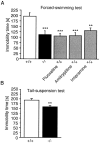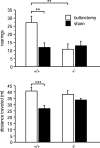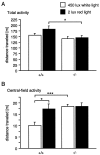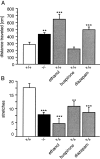Diminished anxiety- and depression-related behaviors in mice with selective deletion of the Tac1 gene
- PMID: 12427862
- PMCID: PMC6757849
- DOI: 10.1523/JNEUROSCI.22-22-10046.2002
Diminished anxiety- and depression-related behaviors in mice with selective deletion of the Tac1 gene
Abstract
The tachykinin neuropeptide substance P and its receptor neurokinin 1 have been implicated in the regulation of many physiological and pathological processes, including the control of emotional behaviors. The present study examines mice with a targeted deletion of the Tac1 gene, which encodes the neuropeptides substance P and neurokinin A, in animal models relevant to depressive illness and anxiety. In depression-related paradigms, Tac1-deficient mice were more active in the Porsolt's forced-swimming test and the tail-suspension test, and they did not become hyperactive after bulbectomy. Tac1 mutant mice were also less fearful in several animal models of anxiety. They were more active and less affected by the light conditions in the central area of the open-field arena; they showed more social interactions in an aversive environment, they were more active in the open areas of an elevated zero-maze, and they had a reduced latency to feed in the Thatcher-Britton conflict paradigm. These results demonstrate that tachykinins are powerful mediators of depression-like or anxiety-related behaviors in mice. The tachykinin system therefore may play an important role in the regulation of emotional states and the development of anxiety disorders and depression.
Figures





Similar articles
-
Hemokinin-1 mediates anxiolytic and anti-depressant-like actions in mice.Brain Behav Immun. 2017 Jan;59:219-232. doi: 10.1016/j.bbi.2016.09.004. Epub 2016 Sep 9. Brain Behav Immun. 2017. PMID: 27621226
-
Modulation of the CRH system by substance P/NKA in an animal model of depression.Behav Brain Res. 2010 Nov 12;213(1):103-8. doi: 10.1016/j.bbr.2010.04.044. Epub 2010 May 8. Behav Brain Res. 2010. PMID: 20438764
-
Genetic inactivation of the NMDA receptor NR2A subunit has anxiolytic- and antidepressant-like effects in mice.Neuropsychopharmacology. 2006 Nov;31(11):2405-14. doi: 10.1038/sj.npp.1301039. Epub 2006 Feb 8. Neuropsychopharmacology. 2006. PMID: 16482087
-
Absence of system xc- in mice decreases anxiety and depressive-like behavior without affecting sensorimotor function or spatial vision.Prog Neuropsychopharmacol Biol Psychiatry. 2015 Jun 3;59:49-58. doi: 10.1016/j.pnpbp.2015.01.010. Epub 2015 Jan 23. Prog Neuropsychopharmacol Biol Psychiatry. 2015. PMID: 25619129
-
Mouse anxiety: the power of knockout.Pharmacogenomics J. 2001;1(3):187-92. doi: 10.1038/sj.tpj.6500016. Pharmacogenomics J. 2001. PMID: 11908755 Review.
Cited by
-
Abnormalities of neurotransmitter and neuropeptide systems in human neuroepithelioma cells infected by three Toxoplasma strains.J Neural Transm (Vienna). 2013 Dec;120(12):1631-9. doi: 10.1007/s00702-013-1064-3. Epub 2013 Jul 3. J Neural Transm (Vienna). 2013. PMID: 23821371 Free PMC article.
-
Identification of genes and gene pathways associated with major depressive disorder by integrative brain analysis of rat and human prefrontal cortex transcriptomes.Transl Psychiatry. 2015 Mar 3;5(3):e519. doi: 10.1038/tp.2015.15. Transl Psychiatry. 2015. PMID: 25734512 Free PMC article.
-
VPAC receptor signaling modulates grouping behavior and social responses to contextual novelty in a gregarious finch: a role for a putative prefrontal cortex homologue.Horm Behav. 2013 Aug;64(3):511-8. doi: 10.1016/j.yhbeh.2013.07.004. Epub 2013 Jul 27. Horm Behav. 2013. PMID: 23899763 Free PMC article.
-
Inactivation of the Mouse L-Proline Transporter PROT Alters Glutamatergic Synapse Biochemistry and Perturbs Behaviors Required to Respond to Environmental Changes.Front Mol Neurosci. 2018 Aug 20;11:279. doi: 10.3389/fnmol.2018.00279. eCollection 2018. Front Mol Neurosci. 2018. PMID: 30177871 Free PMC article.
-
Early life stress differentially modulates distinct forms of brain plasticity in young and adult mice.PLoS One. 2012;7(10):e46004. doi: 10.1371/journal.pone.0046004. Epub 2012 Oct 5. PLoS One. 2012. PMID: 23071534 Free PMC article.
References
-
- Bergstrom M, Fasth KJ, Kilpatrick G, Ward P, Cable KM, Wipperman MD, Sutherland DR, Langstrom B. Brain uptake and receptor binding of two [11C]labeled selective high affinity NK1-antagonists, GR203040 and GR205171–PET studies in rhesus monkey. Neuropharmacology. 2000;39:664–670. - PubMed
-
- Borsini F, Meli A. Is the forced swimming test a suitable model for revealing antidepressant activity? Psychopharmacology (Berl) 1988;94:147–160. - PubMed
-
- Cao YQ, Mantyh PW, Carlson EJ, Gillespie AM, Epstein CJ, Basbaum AI. Primary afferent tachykinins are required to experience moderate to intense pain. Nature. 1998;392:390–394. - PubMed
-
- Cheeta S, Tucci S, Sandhu J, Williams AR, Rupniak NM, File SE. Anxiolytic actions of the substance P (NK1) receptor antagonist L-760735 and the 5-HT1A agonist 8-OH-DPAT in the social interaction test in gerbils. Brain Res. 2001;915:170–175. - PubMed
Publication types
MeSH terms
Substances
LinkOut - more resources
Full Text Sources
Other Literature Sources
Medical
Molecular Biology Databases
